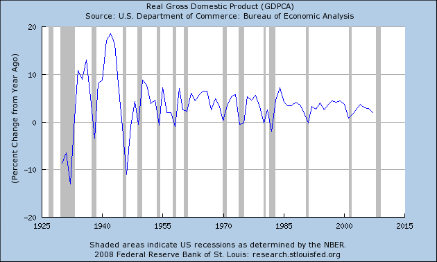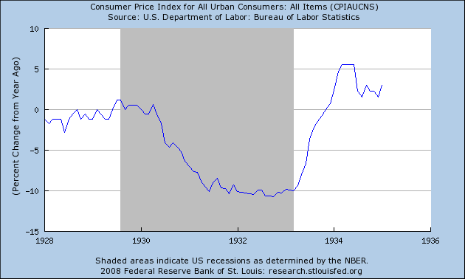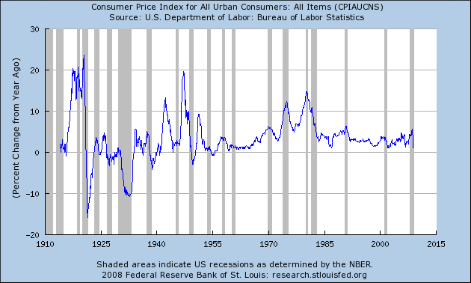This article is the first in a series on the Great Depression. I am collaborating on this series with Bonddad. The purpose of this series is simply to talk about the Great Depression. The reason for writing this article is the emergence of the "FDR made the Depression worse" talking point from the Right Wing Noise Machine -- econ division. While none of the stories using this line have an facts to back them up -- no charts, no graphs no data -- they continue to spew this talking point. So, let's get some data -- as in facts -- to see that actually happened.
"I have no fears for the future of our country. It is bright with hope." - Herber Hoover's Inaugural Address, March 4, 1929.
Let me begin with an excerpt from Milton Friendman's Monetary History of the United States (page 299):
The contraction from 1929 to 1933 was by far the most severe business-cycle contraction during the near-century of US history we cover and it may well have been the most severe in the whole of US history. Though sharper and more prolonged in the US than in most other countries, it was worldwide in scope and rates as the most severe and widely diffused international contraction of modern times.
Pause for a moment and consider the above statement. It wasn't just bad, or slightly bad -- it was the worst economic calamity in US history, bar none:
Friday, March 3, 1933. Across the country the banks of the nation had gradually shuttered their windows and locked their doors. The very machinery of the American economy seemed to be coming to a stop. The rich and fertile nation, overflowing with natural wealth,... lay stricken.
....
The fog of despair lay over the land. One out of every four American workers lacked a job. Factories that had once darkened the skies with smoke stood ghostly and silent, like extinct volcanoes. Families slept in tarpaper shacks and tin-lined caves and scavenged like dogs for food in the city dump. In October the New York City Health Department had reported that over one-fifth of the pupils in public schools were suffering from malnutrition. On the countryside unrest had already flared into violence... Mobs halted mortgage sales, ran the men from the banks and insurance companies out of town....[I]n Nebraska ,,,, the farmers organized a posse, called it the 'Red Army', and took [repossessed] trucks back. In West Virginia, mining families, turned out of their homes, lived in tents along the road on pinto beans and black coffee.
[Numerous voices publicly warned of armed revolt:] Edward A. O'Neal, an Alabama planter, head of the Farm Bureau Federation, bluntly warned a Senate committee, "Unless something is done for the American farmer we will have revolution in the countryside within less than twelve months." ...
[The Secretary of War moved troops from places like Texas to staging grounds closer to the large cities of the east and midwest]...
....
[B]ankruptcy of ideas seemed [ ] complete among the intellectuals. ... On the eve of the inaugural, theologian Reinhold Niebuhr pronounced an obituary on liberal society. ... on the assumption that "capitalism is dying and with the conviction that it ought to die" .... "There is nothing in history to support the thesis that that a dominant class ever yields its position or its privileges in society because its rule has been convicted of ineptness or injustice."
- Arthur M. Schlesinger Jr., "The Crisis of the Old Order"
Let's take a look at the degree of the contraction:
Above is a chart that shows the percentage change in GDP from the preceding year. Notice that for the years 1930 - 1933 (the years highlighted in the Friedman excerpt) GDP decreased 8.6%, 6.4%, 13% and 1.3% from the preceding years, respectively. To place those years in further perspective, here is a chart from the St. Louis Federal Reserve that shows the percentage change in GDP from the previous year. The series is for the last century:
Notice the drop from 1929 - 1933 was by far the most severe of any contraction in the last century by far; there is no comparison to other periods.
From a chained 2000 dollar perspective, total US GDP fell from $865 billion in 1929 to $635.5 billion in 1933. That's a contraction of 26.58%.
Underlying these cold and clinical numbers is the story of human misery on an epic scale:
[By 1930] Across the country the dismal process was beginning, ... Now came the slowdown -- only three days of work a week, then perhaps two, then the layoff. And then the search for a new job -- at first vigorous and hopeful; then sober; then desperate...the unending walk from one plant to the next, the all-night wait to be first for possible work in the morning. And the inexorable news,... "No help wanted here."
And so the search continued, as clothes began to wear out and shoes to fall to pieces...
In the meantime savings were trickling away. ...As savings end, borrowing begins. If there is life insurance, borrowing on that, until it lapses; then loans from relatives and from friends; then the life of credit, from the landlord, from the corner grocer, until the lines of friendship and compassion are snapped. Meat vanishes from the table; lard replaces butter ... the children begin to lack shoes, there clothes are ragged.... Wedding rings are pawned, furniture is sold, the family moves into ever cheaper, damper,dirtier rooms.[Children cried constantly from slow starvation] [Then] the the apple peddlers began to appear on cold street corners, their threadbare clothes brushed and neat...
(Schlesinger, pp. 167-8)
That was 1930. By 1931,
"With no money left for rent, unemployed men and their entire families began to build shack s where they could find unoccupied land."
"Citizens of Chicago,... could be seen digging into heaps of refuse with sticks and hands as soon the as the garbage trucks pulled out."
As the depression wore on, private charities received less and less in donations in order to attempt to carry out an ever more staggering caselood.
By 1932,
relief resources, public and private, dwindled toward the vanishing point
. (Schlesinger, pp. 171, 174)
Let's add to the picture by looking at the year over year change in CPI from the 1929 - 1933 period:
Notice that starting in 1930 prices dropped big time. For the latter half of 1931 and 1932, prices were dropping 10% on a year over year basis. Let's place that drop in historical context:
Notice that the years 1929 - 1933 saw the sharpest decline in prices over the last century save for a period of earlier deflation that occurred before the roaring 20s.
This period of deflation indicates a deflationary cycle was taking place:
"Because the price of goods is falling, consumers have an incentive to delay purchases and consumption until prices fall further, which in turn reduces overall economic activity - contributing to the deflationary spiral.
From an economic point of view, you want a little inflation. This indicates there is a strong enough increase in demand to pull prices higher. But a prolonged price drop indicates there is a serious problem
So the short version is pretty clear. From 1929 - 1933 the US economy experienced the worst economic slowdown in its history:
[By 1932,] National Income which had been $87.4 billion in 1929, fell with the value of the dollar to $41.7 billion in 1932. Unemployment rose: 4 million in 1930, 8 million in 1931, 12 million in 1932. ... Net Investment in 1931 was minus $358 million (in 1929 prices); then next year it fell to a disheartening minus $5.8 billion. .. Wage payments [went down] from $50 billion to $30 billion. And, as prices and income fell, the burdens of indebtedness -- farm mortgages, railroad bonds, municipal and state debts -- became unsupportable.
(Schlesinger, p.248)
In case you were wondering:
The President was a Republican
The Senate was controlled by Republicans
The House was controlled by Republicans from March 4, 1929 - March 3, 1931. From March 4, 1931 to March 3, 1933 the House was tied.
And one thing the Republicans and the plutocrats of the day were sure of, was that government should do absolutely nothing to help its destitute citizenry. When in 1930 a long summer drought killed cattle and crops in the southwest. Hoover asked Congress to appropriate money for government loans to enable farmers to buy seed, fertilizer, and cattle feed, but when Democratic senators sough to apply the same program to human beings in addition to livestock, Hoover "reaffirmed his unwavering opposition to such proposals." (Schlesinger, p. 170)
Hoover appointed Walter S. Gifford, president of AT&T, to the "President's Organization on Unemployment Relief." Appearing before a Senate committee,
"Gifford disclosed imerturbably that he did not know how many people were idle, that he did not know how many were receiving aid, that he did not know that the standards of assistance were in the various states, that he did not know how much money had been raised in his own campaign, that he knew nothing of the ability of local communities to raise relief funds ,, that he did not consider most of this information as of much importance to his job....
But on one question Gifford was clear: he was against federal aid."...that it would reduce the size of private charity." His "sober and considered judgment" was that "federal aid would be a 'disservice' to the jobless."
Gifford was hardly the only precursor of the malign right wing ideology of today:
Albert H. Wiggin of the Chase Manhattan Bank said, "There is no commission or any brain in the world that can prevent [business downturns]." Senator La Follette asked "whether he thought the capacity of human suffering to be unlimited." "I think so." the banker replied.
....
"The fact that we have let nature take its course," said Richard Whitney of the Stock Exchange, "may augur well for the ultimate prosperity of the country." And if recovery were inevitable, then the state must take care to do nothing which might hold it back....
....
Of all the threatened forms of governmental interference, the most sinister, in the judgment of many businessmen, was the dole for the jobless.
....
"If this country ever voted a dole, said Silas Strawn, now head of the United States Chamber of Commerce, "we've hit the toboggan as a nation."...[M]any conservatives affected to regard federal aid to idle men and women as spelling the end of the republic."
(Schlesinger, pp.177-180)
It is worth re-reading the first vignette from Schlesinger above. Republicans today, just like Republicans then, believe that the appropriate response in the face of the ultimate failure of the economic system to provide jobs, housing, or even to prevent a large percentage of its citizenry from starving, was to DO NOTHING.





Comments
really glad you're doing that
I saw on Lou Dobbs yesterday someone coming out with a book on the Great Depression trying to rewrite history and try to claim all of those innane "limited government" and trickle upon economics, if those had been done, would have curtailed it.
I mean it's just ridiculous how they try to shove their philosophy in the face of people when it's pure economic fiction and the results from trickle upon, which is a redistribution of wealth to a super elite class, is well documented.